Öz
Anahtar Kelimeler
ELT writing vocabulary lexical diversity lexical sophistication narrative writing
Kaynakça
- Anderson, J. (2005). Diagnozing foreign language proficiency. London: Continuum.
- Crossley, A., Salsbury, T., McNamara, S., & Jarvis, S. (2010). Predicting lexical proficiency in language learner texts using computational indices. Language Testing, 28(4), 561–580. https://doi.org/10.1177/0265532210378031
- Foster, P., & Skehan, P. (1996). The Influence of planning and task type on second language performance. Studies in Second Language Acquisition, 18(3), 299–323. https://doi.org/10.1017/S0272263100015047
- Gravetter, F., & Forzano, L. (2012). Research Methods for the Behavioral Sciences. New York: Wadsworth Cengage Learning. https://doi.org/January 1, 2011
- Housen, A., Kuiken, F., & Vedder, I. (2012). Complexity, accuracy and fluency: Definitions, measurement and research. In A. Housen, F. Kuiken, & I. Vedder (Eds.), Dimensions of L2 performance and proficiency (pp. 1–20). Amsterdam: John Benjamins B.V.
- Jarvis, S. (2002). Short texts, best-fitting curves and new measures of lexical diversity. Language Testing, 19(1), 57–84. https://doi.org/10.1191/0265532202lt220oa
- Kwon, S. (2009). Lexical richness in L2 writing: How much vocabulary do L2 learners need to use? English Teaching, 64(3), 155–174.
- Kyle, K., & Crossley, S. (2016). The relationship between lexical sophistication and independent and source-based writing. Journal of Second Language Writing, 34, 12–24. https://doi.org/10.1016/j.jslw.2016.10.003
- Laufer, B., & Nation, P. (1995). Vocabulary size and use: Lexical richness in L2 written production. Applied Linguistics, 16(3), 307–322.
- Lindqvist, C., Gudmundson, A., & Bardel, C. (2012). A new approach to measuring lexical sophistication in L2 oral production. In L2 vocabulary acquisition, knowledge and use (pp. 109–126). EUROSLA MONOGRAPHS SERIES 2. Retrieved from http://eurosla.org/monographs/EM02/Lindqvist_etal.pdf
- Malvern, D. (2004). Lexical Diversity and language development: Quantification and assessment. London: Palgrave Macmillan. Retrieved from http://www.palgraveconnect.com/doifinder/10.1057/9780230511804
- Rahimpour, M., Mehrang, F., & Hosseini, P. (2011). Effects of task design on EFL learners ’ written language performance. THE JOURNAL OF ASIA TEFL, 8(2), 95–117.
- Wang, X. (2014). The relationship between lexical diversity and EFL writing proficiency. TESOL, 9, 65–88.
Öz
The nature and size of vocabulary significantly determine quality in a given piece of writing. It therefore follows that an extensive vocabulary repertoire is a key factor to success in academic life. Most certainly, this explains the vast amount of scholarly attention that has been invested in this line of research. In this regard, a wide array of studies have provided evidence suggesting that human assessors of writing quality are substantially influenced by the range and sophistication of the vocabulary used by L2 learners. The studies that offered such evidence used different measurement tools to evaluate the nature and/or size of L2 learners’ vocabulary. However, very few studies have attempted to chart vocabulary knowledge across different college-level proficiency levels in narrative writing productions in the Moroccan context. To contribute to this debate, the present study aims to investigate university L2 learners’ vocabulary knowledge across three proficiency levels from two post-secondary institutions. More specifically, this cross-sectional study operationalized vocabulary knowledge in terms of diversity and sophistication in order to chart growth in the lexical repertoire of 90 participants. Data analysis showed that the participants displayed different levels of vocabulary knowledge. In terms of lexical diversity, second-year students’ vocabulary was as diverse as third-year students but it was not as sophisticated. Nonetheless, sophistication did not differentiate first- and second-year students but it did differentiate between second- and third-year students. Additionally, diversity and sophistication were both good markers of difference between first- and second-year students. The implications of the findings will be discussed.
Anahtar Kelimeler
ELT writing vocabulary lexical diversity lexical sophistication narrative writing
Kaynakça
- Anderson, J. (2005). Diagnozing foreign language proficiency. London: Continuum.
- Crossley, A., Salsbury, T., McNamara, S., & Jarvis, S. (2010). Predicting lexical proficiency in language learner texts using computational indices. Language Testing, 28(4), 561–580. https://doi.org/10.1177/0265532210378031
- Foster, P., & Skehan, P. (1996). The Influence of planning and task type on second language performance. Studies in Second Language Acquisition, 18(3), 299–323. https://doi.org/10.1017/S0272263100015047
- Gravetter, F., & Forzano, L. (2012). Research Methods for the Behavioral Sciences. New York: Wadsworth Cengage Learning. https://doi.org/January 1, 2011
- Housen, A., Kuiken, F., & Vedder, I. (2012). Complexity, accuracy and fluency: Definitions, measurement and research. In A. Housen, F. Kuiken, & I. Vedder (Eds.), Dimensions of L2 performance and proficiency (pp. 1–20). Amsterdam: John Benjamins B.V.
- Jarvis, S. (2002). Short texts, best-fitting curves and new measures of lexical diversity. Language Testing, 19(1), 57–84. https://doi.org/10.1191/0265532202lt220oa
- Kwon, S. (2009). Lexical richness in L2 writing: How much vocabulary do L2 learners need to use? English Teaching, 64(3), 155–174.
- Kyle, K., & Crossley, S. (2016). The relationship between lexical sophistication and independent and source-based writing. Journal of Second Language Writing, 34, 12–24. https://doi.org/10.1016/j.jslw.2016.10.003
- Laufer, B., & Nation, P. (1995). Vocabulary size and use: Lexical richness in L2 written production. Applied Linguistics, 16(3), 307–322.
- Lindqvist, C., Gudmundson, A., & Bardel, C. (2012). A new approach to measuring lexical sophistication in L2 oral production. In L2 vocabulary acquisition, knowledge and use (pp. 109–126). EUROSLA MONOGRAPHS SERIES 2. Retrieved from http://eurosla.org/monographs/EM02/Lindqvist_etal.pdf
- Malvern, D. (2004). Lexical Diversity and language development: Quantification and assessment. London: Palgrave Macmillan. Retrieved from http://www.palgraveconnect.com/doifinder/10.1057/9780230511804
- Rahimpour, M., Mehrang, F., & Hosseini, P. (2011). Effects of task design on EFL learners ’ written language performance. THE JOURNAL OF ASIA TEFL, 8(2), 95–117.
- Wang, X. (2014). The relationship between lexical diversity and EFL writing proficiency. TESOL, 9, 65–88.
Ayrıntılar
| Birincil Dil | İngilizce |
|---|---|
| Konular | İkinci Bir Dil Olarak İngilizce |
| Bölüm | Araştırma Makalesi |
| Yazarlar | |
| Yayımlanma Tarihi | 30 Eylül 2017 |
| Yayımlandığı Sayı | Yıl 2017 Cilt: 5 Sayı: 3 |

